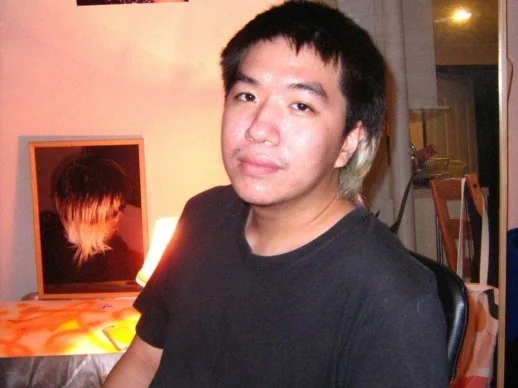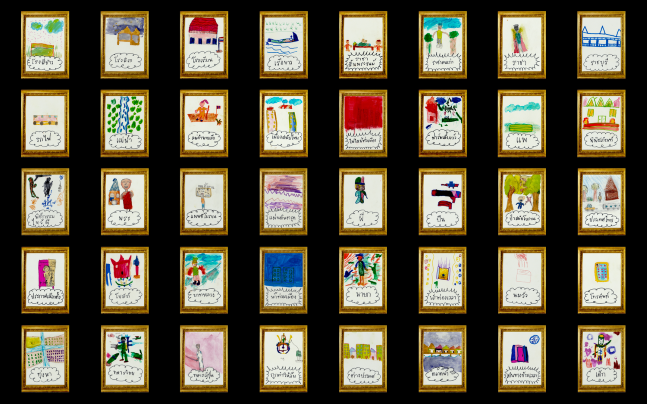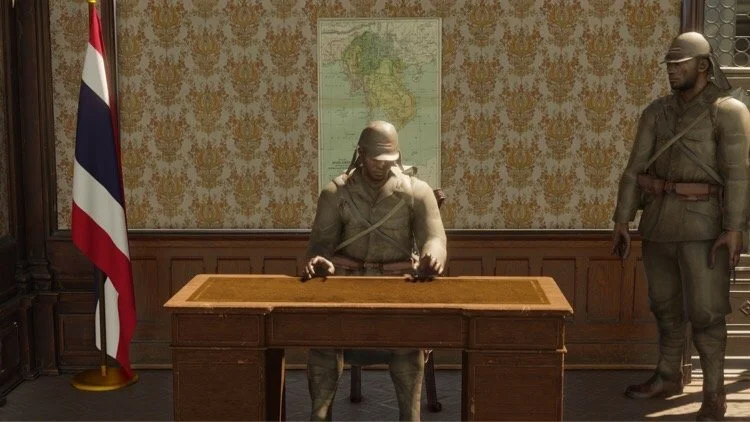Fresh Face: Nanut Thanapornrapee
Participatory storytelling, AI generated images and simulated histories
A&M's Fresh Face is where we profile an emerging artist from the region every month and speak to them about how they kick-started their career, how they continue to sustain their practice and what drives them as artists.
Nanut Thanapornrapee.
Nanut Thanapornrapee’s practice explores the connections among memory, history and technology. Born in 1995 in Bangkok, he holds an undergraduate degree in Journalism and Mass Communication (majoring in Film and Photography) from Thammasat University. His work evinces a deep understanding of the power of media. The artist even cites the iconic photograph of a lynched student taken during the 6 October 1976 massacre as a pivotal moment that changed his perception of Thai history. Nanut hopes that he is able to trigger his audience’s curiosity about their memories so that they would similarly question conservative historical narratives.
Nanut Thanapornrapee, HAWIWI: I Wish I Wrote a History Card Making Workshop, 2021. Image courtesy of the artist.
In the last two years, Nanut’s approach has expanded to include both audience participation and the utilisation of generated images and text. Such a methodology challenges conventional modes of image-making and storytelling, by allowing participants to exercise their agency through gameplay. An example is HAWIWI: I Wish I Wrote a History (2021), a project aimed at retelling local histories in Ratchaburi, Thailand. The artist first conducted research into the city’s context and spoke to elders about their memories of ancestors. Local students then visualised places, people and events related to the city’s history as playing card designs which were used in a board game.
Next, Nanut invited members of a high school archaeology club to retell their city’s history through the board game. Its game mechanics were inspired by Once Upon a Time (Atlas Game, 1994), where players have to compete by rewriting and stealing other’s narratives in order to win. Nanut likens this gameplay to the “narrative war” operating in the real world where victors write the history books. He believes that by giving participants the power to control their own history, it empowers their individual voice and also ignites questions about grand narratives.
“He believes that by giving participants the power to control their own history, it empowers their individual voice and also ignites questions about grand narratives.”
Nanut Thanapornrapee, This History is Auto-Generated (video still), 2022, generated images, 3D animation. Image courtesy of the artist.
Nanut Thanapornrapee, This History is Auto-Generated (video still), 2022, generated images, 3D animation. Image courtesy of the artist.
Similarly, Nanut’s latest work This History is Auto-Generated (2022) explores the complex ways our understanding of history intersects with technology. A language processing artificial intelligence software is employed to create scripted timelines based on key moments in Thai history. Audiences are then invited to play through these scenarios in an interactive novel format, where they can change the path of history. As such, parallel “histories” are created through the game, which ranges from the plausible to the absurd.
However, as the work’s title suggests, the players’ actions are limited by the framework of the game. In his artist statement, he states, “Today our memories are not only controlled by histories but also by algorithms and automation.” He cites how the algorithm consumes our past activity to influence our future actions through advertisement, and also reminds us of our past memories through news feeds of our friends. The project extends into real life workshops where Nanut and participants discuss possible solutions that can be enacted.
This History is Auto-Generated is layered in its reproduction of our technologically-mediated era. It taps into the new possibilities enabled by machine learning but also acknowledges its problematic social consequences when left unchecked. Rather than being a catalyst for polarisation, Nanut’s works create spaces for discourse.
Interview
Nanut Thanapornrapee, HAWIWI: I Wish I Wrote a History, 2021, hardcover book, dual-channel video, card game, generated image. Exhibition view at A Verse on Uncomposed Surface: A Gathering of Becoming Stories, EX SPACE, Sanam Chandra Art Gallery, Silpakorn University, Nakhon Pathom. Image courtesy of the artist.
In 2017, you graduated with a Bachelor in Journalism and Mass Communication majoring in film and photography at Thammasat University, Bangkok. How did you end up pursuing a career in the arts?
In Thailand, the education system is not designed to help us discover ourselves. Therefore, after I graduated from high school, I just chose what I would be happy to spend time studying, which was film and photography. I grew up with the internet torrent culture where I discovered arthouse cinema and anime, which were not part of mainstream culture here. We did not have options for a diversity of interests.
During my senior year in university, I enrolled in an experimental film class. In that class, we studied essays by Walter Benjamin and works by pioneer video artists such as La Jetée. It opened up a totally different discourse and approach from all of my years in the education system. I was inspired to go beyond traditional filmmaking and photography. This was the start of my pursuit of becoming an artist.
Nanut Thanapornrapee, N01SE.jpg, 2019, photography inkjet digital print and risograph. Exhibition view at Sangnual Lab. Image courtesy of the artist.
Nanut Thanapornrapee, 240”-00.JPG, 2019, digital print. Image courtesy of the artist.
How did the opportunity for your first solo exhibition N01SE.jpg (2019) at Sangnual Lab in Bangkok come about? Could you talk about the body of work presented as well as one challenge you faced preparing for it?
I visited Sangnual Lab a couple of times before I approached the owner Napat Vatanakuljaras and introduced my works. We have a number of mutual friends so our discussion was very casual. Sangnual Lab is located on the third and fourth floor of a shophouse selling electronics. This context is related to my project which explores noise in digital photography and the ontology of digital cameras.
The challenge was my lack of experience in exhibition-making, especially using space as medium to support the presentation of my works. Fortunately, I received a lot of help from my friend and curator Nonthachai Sukkankosol. We spent a lot of time in the gallery space, and our discussions greatly helped the development of this exhibition.
Who has been a mentor or an important artistic influence? And why?
An important influence would be Jakrawal Nilthamrong, a teacher from my senior year at university and also my mentor for my first exhibition in the Early Years Project at Bangkok Art & Culture Centre (BACC). He introduced me to multiple approaches that could be used to create moving images, learning from practitioners such as Chris Maker to Apichatpong Weerasethakul. This gave me an open-minded attitude to filmmaking that I carry with me to this day.
What was one important piece of advice you were given?
We do not have to agree on everything. This was the feedback during my first video art screening. I am reminded of this whenever I encounter complicated conflicts in society. Nowadays people are afraid to say what they think if it differs from the majority’s opinion. I believe that we should stand up for our viewpoints because nothing is absolutely right. The clash of different ideologies can lead to new understanding and knowledge.
“I believe that we should stand up for our viewpoints because nothing is absolutely right. The clash of different ideologies can lead to new understanding and knowledge.”
Nanut Thanapornrapee, Neonatus/Neotokyo, 2020, generated images, digital print. Image courtesy of the artist and Wasawat Somno.
Recently, you have explored the use of generated images in works such as Neonatus/ Neotokyo (2020). What is GAN (generative adversarial network)? And why are you interested in this process?
Neonatus/Neotokyo is a collaborative project with software-engineer Wasawat Somno. It was created on the occasion of the first anniversary of the Tokyo Hot restaurant where they sell street dishes called kanom tokyo. This is a pancake stuffed with various meat, sweets and vegetables. We are interested in the form of a pancake which is similar to the spiral of the universe and the question: could a computer make kanom tokyo?
We decided to employ GAN, a method in which computers use their based network (image) to match and combine to create a new image. In order to create kanom tokyo, this computer is trained to recognise what the dish looks like by feeding it a hundred photos. I think of the computer as a new born baby who has not been taught about this world and the first thing that they will know is a kanom tokyo.
I am interested in this generative process because it can enlarge our imagination regarding a particular subject and let us explore unknown possibilities. Even though the process is done by a computer, the data or network they use still comes from humans.
“I am interested in this generative process because it can enlarge our imagination regarding a particular subject and let us explore unknown possibilities.”
Nanut Thanapornrapee, No Man’s Land, 2018, documentary, found object installation. Exhibition view at Bangkok Art and Cultural Centre (BACC). Image courtesy of the artist, Nu Muhammad and BACC.
Nanut Thanapornrapee, No Man’s Land, 2018, documentary, found object installation. Exhibition view at Bangkok Art and Cultural Centre (BACC). Image courtesy of the artist, Nu Muhammad and BACC.
Participation or social engagement is another aspect of your practice. You have worked with Rohingya immigrants in No Man’s Land (2018) as well as students in elementary and high schools for HAWIWI: I Wish I Wrote a History (2021). Why is it important to have this participatory element in the works? And how do you decide which issues or communities to work with?
When preparing No Man’s Land, I was inspired by conversations with Nu Muhummad, a Rohingya individual who migrated from Myanmar to Thailand 30 years ago. Nu has many experiences to share and an intimate way of storytelling that brings the audience closer to him. Hence, I decided to collaborate with him not as a subject but as a co-artist. In the installation process, Nu made most of the decisions. We discussed how to create a sense of home in exhibition space, and I provided facilities and technical support. The project opened my outlook toward meta-narratives and storytelling.
Later in HAWIWI, Baan Norg introduced their project methodology which encompassed many approaches toward community collaboration. They helped organise the workshop and interview session which created a positive bond between the locals and artists. Participants of diverse ages and backgrounds resulted in a dynamic process and experience with HAWIWI. No Man’s Land and HAWIWI encouraged me to think of art’s purpose as a common ground for exchange, playing with narratives and using our voices to create history.
Nanut Thanapornrapee, HAWIWI: I Wish I Wrote a History, 2021, card game. Image courtesy of the artist.
Were you invited by Baan Norg Collaborative Art and Culture to produce HAWIWI? What was the process of creating the work like? And what role did Baan Norg play in this framework?
The opportunity came about through my application to Baan Norg’s open call for site-specific projects in Ratchaburi, Thailand. Baan Norg acted as a facilitator by connecting me with the locals. Together with Taiwanese artist Hsu Chia-Wei, they also provided curatorial support and mentorship.
In the research stage, we visited the locals to gather oral history and memories of their ancestors who settled in Ratchaburi. I analysed the narrative and discussed with Baan Norg to understand the city and how its local government addressed its historical context.
The mentoring process played a big role in the development of HAWIWI. That was how I ended up using the board game as an approach to allow more freedom to re-imagine the city’s history. This methodology is based on the game Once Upon a Time, where players have to compete by rewriting and stealing each other’s narratives in order to be the winner.
In HAWIWI, the deck of cards with characters, places and events related to Ratchaburi is a key to bridge past narratives with new ones told by a younger generation. They also help visualise aspects of the story. I invited members of a high school archaeology club to retell their city’s history. To abide by pandemic regulations, this card-playing session happened online. After the session, I collected all of the narratives to create a history book as well as a film which contains a record of the game, government propaganda and a tracing of the Mae Klong River in Ratchaburi.
The river was a crucial part in Ratchaburi history and life. About 100 years ago, the government changed the traditional industry from plant agriculture to cattle farming which damaged the river and erased cultural knowledge of minority groups in Ratchaburi. Another aspect of state control is seen in dams that affect water levels, once even causing a flood in the town. In the film, I used software that tracked the flow of the river via video to visualise the manipulation of the river stream in Ratchaburi.
“No Man’s Land and HAWIWI encouraged me to think of art’s purpose as a common ground for exchange, playing with narratives and using our voices to create history.”
Could you share your favourite art space or gallery in your country? Why are you drawn to that space and what does it offer to you or your practice?
The art scene in Thailand does not offer many opportunities for emerging or non-traditional artists so we have to create spaces by ourselves. This fosters community and brings together friends who share interests and passion. Speedy Grandma is one of the spaces where alternative art and cultural practitioners can hang out and exchange thoughts on everything, which in turn leads to collaboration etc.
What are your hopes for your own local art scene, and regionally as well?
My hope for the Thai art scene is still uncertain because the military junta governance is corrupting our system and well-being. Only after we have a real elected government can everything move forward again.
With regards to the regional art scene, I think Southeast Asian cultures and histories intersect in many ways. However, there is a shortage of local funding, especially for emerging and alternative practitioners. Most of it comes from western sources and without institutional support or recommendation, it is very competitive.
Nanut Thanapornrapee, This History is Auto-Generated (video still), 2022, generated images, 3D animation. Image courtesy of the artist.
Are there any upcoming projects that you would like to share more information on?
My upcoming solo exhibition is titled The History is Auto-Generated and it probes into how we perceive and construct history, and ultimately participate in it. In a landscape of indirect or representative political action, it can be argued that history has always been simulated. History is justified, recorded and distributed retroactively. This project uses GPT-3, a language processing artificial intelligence (AI) to look at different pivotal moments in Thai history, from crackdowns of student protests to early efforts of nation building.
The exhibition continues from the first phase of the project, where audiences are invited to "play" through the AI scripted time lines in an interactive novel format. Here, they can imagine and realise for themselves agency in determining the path of history. The game tells different stories: from a lone gunman attempting to topple a dictatorship, to a protest group confronting mythical soldiers and the establishment of a new state. This is an attempt at engaging with historical narratives to derive new modes of resistances through roleplaying and fictional world building. The aim is to reclaim lost narratives.
The scenarios are then animated into movies with parallel universes, composed with different AI elements in the visualisation process. Finally, the project will extend to real life workshops to perform and enact solutions to the scenarios.












